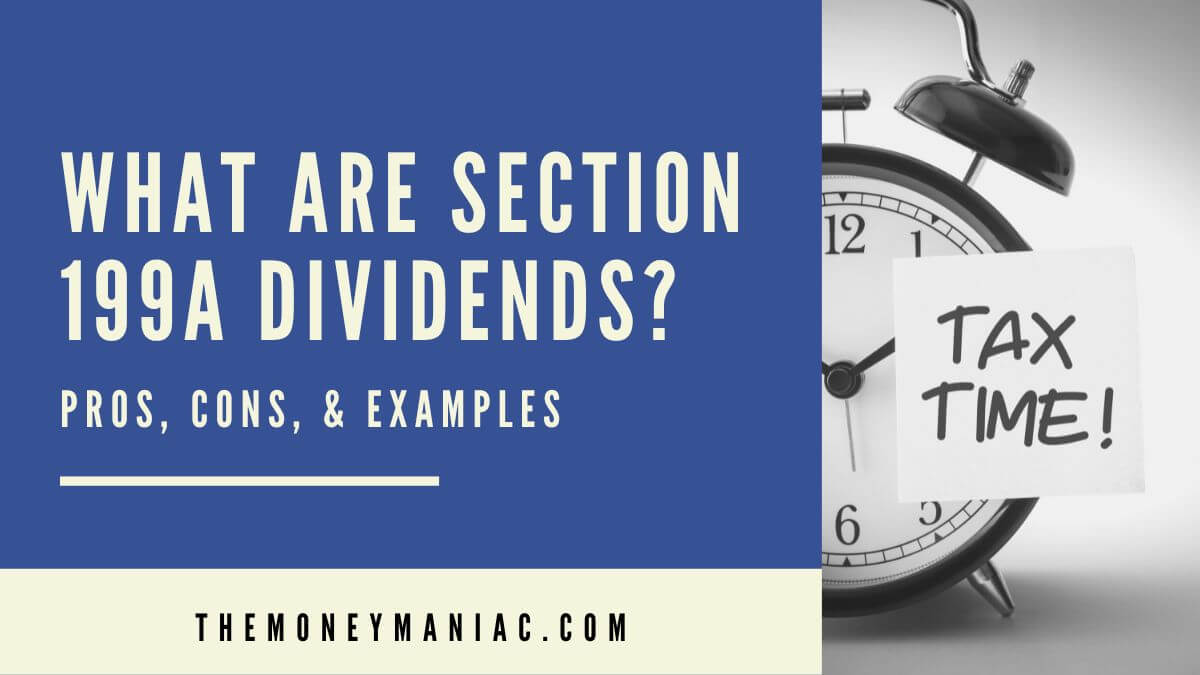Section 199a dividends offer investors a tax-efficient way to earn passive income. But many people still don’t know what they are or how they work.
Don’t worry! This guide covers everything you need to know about Section 199a dividends. We’ll show you what they are, how to accurately report them on your taxes, and how they can put more money in your pocket.
What are Section 199a Dividends?
Section 199a dividends are cash distributions paid by certain REITs (Real Estate Investment Trusts).
These dividends get their name from Section 199a of the tax code, which was established as part of the 2017 Tax Cuts and Jobs Act. This act was a comprehensive tax reform effort aimed at stimulating economic growth and providing tax relief for individuals and businesses.
The main benefit of Section 199a dividends is that they qualify for a special 20% tax deduction.
However, the window of opportunity to take advantage of this deduction is closing. The law will expire on December 31, 2025, unless Congress acts to extend it before then.
What are REITs?
REITs are investment vehicles that own, operate, and finance real estate assets.
They were first created by Congress in 1960. Their purpose is to allow all investors (especially smaller investors) the opportunity to invest in large-scale, income-producing real estate without needing a large pool of capital.
REITs generate income through their real estate investments, typically in the form of rental income or capital gains. By law, they are required to distribute at least 90% of this taxable income to shareholders in the form of dividends.
Except for a few rare cases, all domestic REIT dividends qualify under Section 199A and are eligible for the 20% deduction.
Tax Treatment of Section 199a Dividends
To ensure you get the full benefit of this special tax deduction, let’s explore how these dividends are reported and where to include them on your federal tax return.
What are the Qualification Requirements?
To qualify for the Section 199a deduction, shareholders must own REIT shares for a minimum of 46 days within a 91-day window.
This window begins 45 days before the ex-dividend date and extends for 45 days after. You can count the day you sell your shares as part of these 46 days, but not the day you purchase them.
How do I Know if I Received Section 199a Dividends?
If you own shares in a REIT (or a fund that invests in REITs), these dividends are reported on form 1099 Div in Box 5.
Keep in mind that they are also included in Box 1 as part of your total ordinary dividends.
Where do I Report Section 199a Dividends on My Tax Return?
When filing your federal taxes, you report these dividends in two of three places depending on your income:
1. Most taxpayers will report these dividends on Line 6 of Form 8995.
2. If your income exceeds the threshold for using Form 8995 ($182,100 for single tax filers or $364,200 for joint filers in 2023), you report them on Line 28 of Form 8995-A.
3. The figures from Form 8995 or Form 8995-A also flow through to Line 13 on your 1040 tax form.
Section 199a Dividends Benefits
The key reasons to include these special dividends in your investment strategy are:
1. No Income Limits
One of the primary benefits of these dividends is that you get a 20% tax deduction regardless of your income level, unlike other QBI deductions.
This makes them especially appealing to high-income earners who have limited options to lower their tax liability.
2. No Need to Itemize
You also don’t need to itemize to take advantage of this tax deduction. It is accessible to everyone, including those who opt for the standard deduction.
3. Directly Lowers Taxes
This deduction can result in substantial tax savings. To illustrate, let’s take a look at an example.
Taxpayer A receives $10,000 in ordinary dividends and is in the 22% tax bracket. The marginal taxes owed on these dividends would total $2,200. ($10,000 x 22%)
On the other hand, taxpayer B receives $10,000 in Section 199a dividends. After the 20% tax deduction, the taxable dividend income is only $8,000. Now, using the same 22% tax rate, the tax liability would only be $1,760.
That’s a savings of $440!
Section 199a Dividends Limitations
While Section 199a dividends can help lower your taxes, they do have a few limitations. Here are the drawbacks to consider:
1. Limited to Domestic REIT Ownership
These dividends are only available to shareholders of domestic Real Estate Investment Trusts. Investments in international REITs don’t qualify for this deduction.
2. Taxed as Ordinary Income
Despite the initial deduction, these dividends are ultimately taxed as ordinary income.
3. No Impact on Adjusted Gross Income (AGI)
This tax deduction doesn’t reduce your Adjusted Gross Income (AGI) or allow you to move to a lower tax bracket.
4. Expiration Date
The special tax deduction is set to expire at midnight on December 31, 2025, unless Congress acts to extend the provision. Keep an eye out for legislative changes that could affect their availability in the future.
Final Thoughts
Section 199a dividends offer a limited-time opportunity for REIT investors to lower their tax bills.
Although the 20% tax deduction may not last forever, it can make quite a difference when comparing REITs to other income investments. So be sure to factor your tax strategy and Section 199a dividends into the equation when making your next investment.



